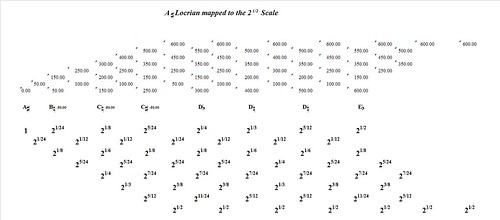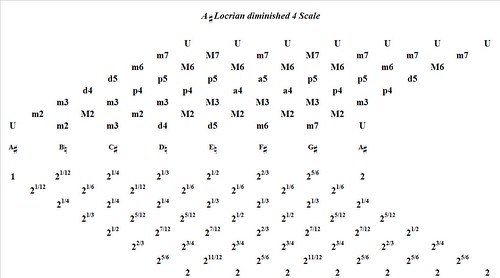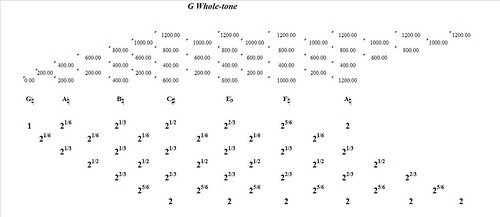
The F Locrian 1% wide Scale. The standard, equal tempered F Locrian scale deliberately detuned by stretching the intervals outward. This leads to the noticeably "out of tune" octave that is 12 cents sharp.


 Terry Riley: Atlantis Nath. I wrote about this one earlier. I'm still charmed by it - warts and all.
Terry Riley: Atlantis Nath. I wrote about this one earlier. I'm still charmed by it - warts and all. Peter Apfelbaum and the Hieroglyphics Ensemble: Jodoji Brightness. I love the compositions/arrangements on this one. The setting of the Dylan Thomas poem "The Hand That Signed the Paper" opens my ears to some outstanding words.
Peter Apfelbaum and the Hieroglyphics Ensemble: Jodoji Brightness. I love the compositions/arrangements on this one. The setting of the Dylan Thomas poem "The Hand That Signed the Paper" opens my ears to some outstanding words. Terry Riley: The Book of Abbeyozzud. A perfect example of the "moving target" quality of Terry Riley's output. These are great arrangements for acoustic guitar and percussion that are a real sonic departure from other Riley soundscapes. This is one I keep coming back to.
Terry Riley: The Book of Abbeyozzud. A perfect example of the "moving target" quality of Terry Riley's output. These are great arrangements for acoustic guitar and percussion that are a real sonic departure from other Riley soundscapes. This is one I keep coming back to. Albert Ayler: Holy Ghost box set Disc 1. This is another one I've written about in this space. I keep going back to hear Ayler and Cecil Taylor playing together.
Albert Ayler: Holy Ghost box set Disc 1. This is another one I've written about in this space. I keep going back to hear Ayler and Cecil Taylor playing together. The Bad Plus: Suspicious Activity? Another one I've mentioned earlier. It keeps sounding cool.
The Bad Plus: Suspicious Activity? Another one I've mentioned earlier. It keeps sounding cool. Elliott Sharp/Orchestra Carbon: Abstract Repressionism: 1990 - 1999. This one gets plenty of rotation here at HurdAudio. Exquisitely ugly and some great thematic lines that really stick with you.
Elliott Sharp/Orchestra Carbon: Abstract Repressionism: 1990 - 1999. This one gets plenty of rotation here at HurdAudio. Exquisitely ugly and some great thematic lines that really stick with you. James Tenney: Postal Pieces. Rembering this inspiring composer, teacher and friend. These conceptual, post-card sized compositions are stunning examples of how much sound lurks within simple forms and ideas. These pieces really open up the ears.
James Tenney: Postal Pieces. Rembering this inspiring composer, teacher and friend. These conceptual, post-card sized compositions are stunning examples of how much sound lurks within simple forms and ideas. These pieces really open up the ears.
 Audio realization of the D Sharp Locrian Scale.
Audio realization of the D Sharp Locrian Scale.
 I enjoyed the Instant Composers Pool's second set at An Die Musik last night. This 10-piece ensemble has nice range and some great leadership/chemistry from pianist Misha Mengelberg. Drummer Han Bennink is also a significant attraction. I was also impressed with the arrangements and chops of saxophonist Michael Moore.
I enjoyed the Instant Composers Pool's second set at An Die Musik last night. This 10-piece ensemble has nice range and some great leadership/chemistry from pianist Misha Mengelberg. Drummer Han Bennink is also a significant attraction. I was also impressed with the arrangements and chops of saxophonist Michael Moore. 


 It seems that this is the year the world is starting to catch up to Ornette Coleman. With his lifetime achievement award and critical acclaim and buzz for last year's Sound Grammar, the old revolutionary is getting his due as he turns 77. The beauty of Coleman's output is clear to anyone who simply listens. And it takes time before enough sympathetic ears catch on to such an original, harmolodic soul.
It seems that this is the year the world is starting to catch up to Ornette Coleman. With his lifetime achievement award and critical acclaim and buzz for last year's Sound Grammar, the old revolutionary is getting his due as he turns 77. The beauty of Coleman's output is clear to anyone who simply listens. And it takes time before enough sympathetic ears catch on to such an original, harmolodic soul.

